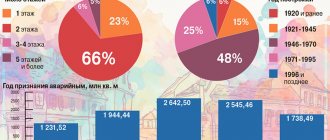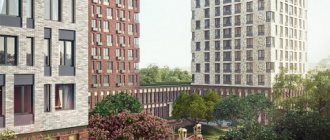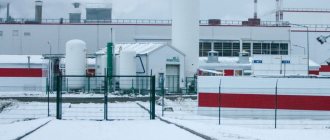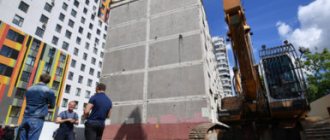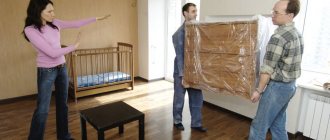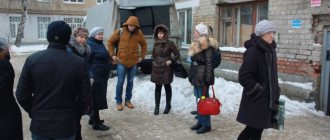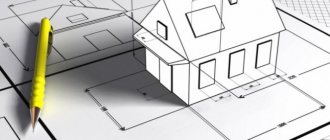How to recognize a house as unsafe is a question asked by owners who want to change their living space to a more comfortable one. But for this, an apartment building must be recognized as unsafe in accordance with the procedure established by law . The Soviet era left us a legacy of housing stock, which is in a deplorable state and is becoming more and more destroyed every year. Over the past 25 years, not much new housing has been built and, as a result, millions of square meters of emergency housing have been created, in which women, children and the elderly live. Many emergency houses are houses without amenities, in which even the toilet is located on the street. Since the beginning of a large-scale federal program for relocation from dilapidated housing, citizens living in unsuitable housing have a chance to improve their living conditions and get comfortable apartments.
Recognition of a house as unsafe and subject to demolition
The recognition of a house as unsafe and subject to demolition is regulated by Decree 47 of the Government of the Russian Federation of January 28, 2006.
In accordance with this resolution, the owners are explained the procedure for submitting documents to recognize a house as unsafe, how to do this and where to submit them. So, if the owner of a premises in an apartment building believes that the house is in a deplorable condition, then he has the right to submit documents to recognize the apartment building as unfit for habitation and in disrepair. In general, no legislative act specifies how many people should submit documents, one or more. If an apartment building is in a condition where no major repairs can help, then the interdepartmental commission is obliged to recognize it as unfit for habitation and in disrepair. The main documents in this case will be a technical passport for an apartment building, which will necessarily indicate the percentage of depreciation of the building, a state housing inspection report and an examination of design and survey work, the conclusions of which should confirm the inappropriateness of major repairs and the unsuitability of people living in the house. Such documents can be submitted either by one home owner or by a group of them. Due to the significant costs of conducting the examination, the best option would be for all interested parties to unite. Many citizens are not aware of their rights and believe that the local administration should recognize the house as unsafe. Of course, if there is a municipal share in the house, then the administration does have this opportunity, but not the obligation. In many regions of the country, prosecutors file lawsuits against local governments in defense of the rights of citizens on the obligation of the administration to initiate the procedure for recognizing houses as unsafe and subject to demolition. This position has significantly increased the number of houses recognized as unsafe throughout the country. But in the pursuit of statistics, the opinions of the citizens themselves, who did not want this, were not taken into account.
What does the owner receive if a residential building is recognized as unsafe and subject to demolition?
If a residential building is recognized as unsafe and subject to demolition, improvement of living conditions can occur in three ways. First, you are waiting for the house to begin to be resettled under the federal program for relocation from dilapidated and dilapidated housing. In this case, you need to check with the local administration whether the house is included in this program. Second, the house is being resettled by the local government at its own expense. And third, you yourself initiate a lawsuit through the court to obtain comfortable living quarters. In this case, you can get a living space with an area no less than what you currently occupy and a number of rooms no less than what is currently in use. You can also change the method of obtaining housing and replace it with cash.
In order to recognize a house as unfit for habitation and in disrepair, the applicant must submit the following documents to the interdepartmental commission for consideration:
- statement;
- expertise;
- State Housing Inspectorate report on the unsatisfactory condition of the house;
- property documents or social tenancy agreement;
- technical certificate.
After submitting these documents, the commission reviews them within 30 days and gives its conclusion. If the commission concludes that a residential building is recognized as unsafe, then local authorities issue a resolution or order recognizing the house as unsafe. This document will be the main document on the path to acquiring new housing. Whether a residential building is subject to demolition or not depends on whether the house is an architectural monument. If so, then such a house cannot be demolished, but must be reconstructed.
Inspection of residential dilapidated structures and buildings
Dilapidated and emergency housing. What is the difference and why is one subject to resettlement and the other not? In fact, the concept of emergency housing is described in the DECISION OF THE GOVERNMENT OF THE RUSSIAN FEDERATION dated January 28, 2006 No. 47 “On approval of the Regulations on recognizing premises as residential premises, residential premises unsuitable for habitation and an apartment building as unsafe and subject to demolition or reconstruction,” which states: “ 4 A residential premises is an isolated premises that is intended for the residence of citizens, is immovable property and is suitable for habitation.
5. Residential premises are recognized as: residential building - an individually defined building, which consists of rooms, as well as premises for auxiliary use, intended to satisfy citizens' household and other needs related to their residence in it; apartment - a structurally separate room in an apartment building, providing direct access to the common areas in such a house and consisting of one or more rooms, as well as premises for auxiliary use, intended for citizens to satisfy household and other needs related to their residence in such a building in a separate room; room - part of a residential building or apartment, intended for use as a place of direct residence of citizens in a residential building or apartment. 6. An apartment building is a collection of two or more apartments that have independent access either to a land plot adjacent to a residential building or to common areas in such a building. An apartment building contains elements of common property of the owners of premises in such a building in accordance with housing legislation. Premises for auxiliary use, as well as premises that are part of the common property of the owners of premises in an apartment building, are not allowed to be used as residential premises. 7. Recognition of premises as residential premises suitable (unsuitable) for citizens to live in, as well as an apartment building as unsafe and subject to demolition or reconstruction, is carried out by an interdepartmental commission created for these purposes (hereinafter referred to as the commission), based on an assessment of the compliance of the specified premises and house with those established in this Regulations requirements (paragraph supplemented since August 18, 2007 by Decree of the Government of the Russian Federation dated August 2, 2007 N 494 - see previous edition), and in part II. , formulated “Requirements that a residential premises must meet” and in Part III. Grounds for recognizing a residential premises as unsuitable for habitation and an apartment building as unsafe and subject to demolition or reconstruction “33. The basis for recognizing a residential premises as unsuitable for habitation is the presence of identified harmful factors in the human environment that do not allow ensuring the safety of life and health of citizens due to: deterioration due to physical wear and tear during the operation of the building as a whole or its individual parts, leading to a decrease in operational characteristics to an unacceptable level of building reliability, strength and stability of building structures and foundations; changes in the environment and microclimate parameters of a residential premises, which do not allow compliance with the necessary sanitary and epidemiological requirements and hygienic standards in terms of the content of chemical and biological substances potentially hazardous to humans, atmospheric air quality, background radiation levels and physical factors of the presence of sources of noise, vibration, electromagnetic fields. 34. Residential premises located in prefabricated, brick and stone houses, as well as in wooden houses and houses made from local materials, with deformations of foundations, walls, load-bearing structures and a significant degree of biological damage to elements of wooden structures, which indicate the exhaustion of load-bearing capacity and danger collapses are unsuitable for habitation due to the recognition of an apartment building as unsafe and subject to demolition or reconstruction (the clause was supplemented on August 18, 2007 by Decree of the Government of the Russian Federation of August 2, 2007 N 494 - see the previous edition). 35. Residential premises located in residential buildings located in areas where sanitary and epidemiological safety indicators in terms of physical factors (noise, vibration, electromagnetic and ionizing radiation), concentrations of chemical and biological substances in the atmospheric air and soil, established in Section II of these Regulations, as well as in residential buildings located in industrial zones, areas of engineering and transport infrastructure and in sanitary protection zones, should be considered unsuitable for living in cases where engineering and design solutions cannot minimize risk criteria to an acceptable level.
36. unsuitable for living . Apartment buildings located in these zones are recognized as unsafe and subject to demolition or reconstruction (the paragraph was supplemented from August 18, 2007 by Decree of the Government of the Russian Federation of August 2, 2007 N 494 - see the previous edition). Residential premises located in the zone of probable destruction during man-made accidents determined by the authorized federal executive body should be considered unsuitable for living Apartment buildings located in these zones are recognized as unsafe and subject to demolition or reconstruction. In these Regulations, the zone of probable destruction in the event of man-made accidents means the territory within the boundaries of which there are residential premises and apartment buildings that are at risk of destruction in connection with a man-made accident (the paragraph was additionally included on August 18, 2007 by the Decree of the Government of the Russian Federation dated August 2, 2007 N 494). 37. Residential premises located in areas adjacent to overhead AC power lines and other objects that create an electric field strength of industrial frequency 50 Hz of more than 1 kV/m and magnetic induction at a height of 1.8 m from the earth’s surface should be considered unsuitable for living. fields of industrial frequency 50 Hz more than 50 µT. 38. Residential premises located in apartment buildings damaged as a result of explosions, accidents, fires, earthquakes, uneven soil subsidence, as well as other complex geological phenomena, should be considered unsuitable for living if restoration work is technically impossible or economically infeasible and the technical condition of these houses and building structures is characterized by a decrease in load-bearing capacity and operational characteristics, which pose a danger to the occupancy of people and the safety of engineering equipment. These apartment buildings are considered unsafe and subject to demolition. 39. Rooms with windows facing highways, with a noise level above the maximum permissible standard specified in paragraph 26 of these Regulations, should be considered unsuitable for living if, with the help of engineering and design solutions, it is impossible to reduce the noise level to an acceptable value. 40. Residential premises above or adjacent to which a device for flushing and cleaning the garbage chute is located should be considered unsuitable for living. 41. The following cannot serve as a basis for declaring a residential premises unfit for habitation: the absence of a centralized sewerage system and hot water supply in a one- and two-story residential building; the absence in a residential building of more than 5 floors of an elevator and a garbage chute, if this residential building, due to physical wear and tear, is in a limited working condition and is not subject to major repairs and reconstruction; inconsistency of the space-planning solution of residential premises and their location with the minimum area of rooms and auxiliary premises of the apartment in an operating residential building, designed and built according to previously valid regulatory documentation, with currently adopted space-planning decisions, if this solution satisfies the ergonomic requirements regarding the placement of the necessary a set of furniture and functional equipment.", and parts IV. The procedure for recognizing premises as residential premises, residential premises unsuitable for habitation and an apartment building as unsafe and subject to demolition or reconstruction.”
In addition, there is DECREE OF THE GOVERNMENT OF THE RUSSIAN FEDERATION dated June 4, 2007 No. 344 “On approval of the Rules for the provision of subsidies from the federal budget to the budgets of constituent entities of the Russian Federation for carrying out measures to resettle citizens from housing stock recognized as unsuitable for habitation, and (or) housing stock with high level of wear and tear”, which states: In order to implement the activities of the subprogram “Modernization of municipal infrastructure facilities” of the federal target program “Housing” for 2002-2010, the Government of the Russian Federation decides: 1. To approve the attached Rules for the provision of subsidies from the federal budget to the budgets of constituent entities of the Russian Federation for carrying out measures to resettle citizens from housing stock recognized as unsuitable for living, and (or) housing stock with a high level of wear and tear (clause as amended by Decree of the Government of the Russian Federation of January 27, 2009 N 36 - see the previous edition).
As indicated by the RULES for the provision of subsidies from the federal budget to the budgets of the constituent entities of the Russian Federation for carrying out measures to resettle citizens from housing stock recognized as unsuitable for habitation, and (or) housing stock with a high level of wear and tear * (as amended on November 11, 2009) of the “Russian Federation dated January 27, 2009 N 36 - see previous edition). In these Rules, unfit for habitation means residential premises recognized as unsuitable for habitation, including due to a high (more than 70 percent) level of wear and tear, and apartment buildings recognized as unsafe and subject to demolition, in accordance with the Regulations on the recognition of premises as residential premises , residential premises unsuitable for habitation and apartment buildings in disrepair and subject to demolition.”
Thus, as can be seen from these fundamental government regulations, there is no mention anywhere of any dilapidated housing. Meanwhile, according to the document “Methodology for determining the physical deterioration of civil buildings,” the concept of dilapidated and emergency housing is determined on the basis of an examination of the physical deterioration of the main load-bearing and enclosing structures, which is determined during an independent construction and technical examination of the main load-bearing and enclosing structures. At the same time, the condition and load-bearing capacity of the main load-bearing and enclosing structures are determined and the possibility of using the premises is assessed from the point of view of the requirements imposed by the current regulatory and technical documents and Decrees of the Government of the Russian Federation. Moreover, according to the document “Methodology for determining the physical deterioration of civil buildings,” the concept of dilapidated housing is determined from the cost of restoration repairs “12. If there are no tables in this methodology for any low-value or rarely encountered structural elements, as well as when new types of structures and materials appear, tables of structural elements of similar nature or the following enlarged scale of physical wear should be used.
| Physical deterioration | Technical condition assessment | General characteristics of technical condition | Approximate cost of major repairs, % of the replacement cost of structural elements |
| 1 | 2 | 3 | 4 |
| 0-20 | good | There is no damage or deformation. There are individual minor defects that can be eliminated during routine repairs and do not affect the operation of the structural element. Major repairs can only be carried out in certain areas that have relatively increased wear | 0-11 |
| 21-40 | Satisfactory | The structural elements are generally serviceable, but require some major repairs, which are most appropriate at this stage. | 12-36 |
| 41-60 | Unsatisfactory | Operation of structural elements is possible only under the condition of significant overhaul. | 38-90 |
| 61-80 | Dilapidated | The condition of the load-bearing structural elements is poor, and the load-bearing elements are very dilapidated. Limited performance of their functions by structural elements is possible only after security measures are taken or a complete replacement of the structural element | 93-120 |
| 81-100 | Worthless | Structural elements are in a destroyed state. When 100% wear occurs, the remains of the structural element are completely eliminated. | — |
| Note. Physical wear and tear of gas and elevator equipment is determined by specialized operating organizations in accordance with departmental instructions. | |||
At the same time, the concept of accident rate is not used in this methodology. The concept of accident rate is contained in the document GOST R 53778-2010 “BUILDINGS AND STRUCTURES. RULES FOR INSPECTION AND MONITORING OF TECHNICAL CONDITION": "3.10 standard technical condition: Category of technical condition in which the quantitative and qualitative values of the parameters of all criteria for assessing the technical condition of building structures of buildings and structures, including the condition of the foundation soils, correspond to the values established in the design documentation, taking into account the limits their changes. 3.11 serviceable technical condition: Category of technical condition in which some of the assessed monitored parameters do not meet the requirements of the design or standards, but existing violations of the requirements in specific operating conditions do not lead to a malfunction, and the required bearing capacity of structures and foundation soils, taking into account the influence of existing defects and damage are guaranteed. 3.12 limited serviceable technical condition: Category of technical condition of a building structure or a building and structure as a whole, including the condition of foundation soils, in which there are tilts, defects and damages that lead to a decrease in bearing capacity, but there is no danger of sudden destruction, loss of stability or overturning, and the functioning of structures and operation of a building or structure is possible either by monitoring (monitoring) the technical condition, or by carrying out the necessary measures to restore or strengthen structures and (or) foundation soils and subsequent monitoring of the technical condition (if necessary). 3.13 emergency condition: Category of the technical condition of a building structure or a building and structure as a whole, including the condition of the foundation soils, characterized by damage and deformations indicating the exhaustion of the bearing capacity and the danger of collapse and (or) characterized by tilts that can cause loss of stability of the object.” However, GOST R 53778-2010 cannot be used when conducting forensic examinations, which is directly stated in its text, since it is recommended. In this regard, the main document is SP 13-102-2003 “Rules for the inspection of load-bearing building structures of buildings and structures”, which directly states:
1 SCOPE OF APPLICATION 1.1 These Rules are intended for use in the inspection of building structures of buildings and structures for residential, public, administrative and industrial purposes in order to determine their technical condition, and can also be used in deciding questions about the suitability of residential buildings for living in them. The rules regulate the procedure for conducting an inspection of building structures, determine the schematic diagram and scope of work, allowing an objective assessment of the technical condition, the actual load-bearing capacity of structures and, if necessary, make informed technical decisions on repair and restoration measures or methods of reinforcement. 1.2 The rules have been developed in accordance with the requirements of current regulatory and technical documents.”
Categories of technical condition are defined in SP 13-102-2003 “Rules for the inspection of load-bearing building structures of buildings and structures” as: “ Category of technical condition - the degree of serviceability of a building structure or a building and structure as a whole, established depending on the proportion of reduction in load-bearing capacity and operational characteristics of structures. Assessment of technical condition - establishing the degree of damage and the category of technical condition of building structures or buildings and structures as a whole based on a comparison of the actual values of quantitatively assessed characteristics with the values of the same characteristics established by a project or regulatory document. Standard level of technical condition is a category of technical condition in which the quantitative and qualitative values of the parameters of all criteria for assessing the technical condition of building structures of buildings and structures comply with the requirements of regulatory documents (SNiP, TSN, GOST, TU, etc.). Serviceable condition is a category of technical condition of a building structure or a building and structure as a whole, characterized by the absence of defects and damage that affect the reduction of load-bearing capacity and serviceability. Serviceable condition - a category of technical condition in which some of the numerically assessed controlled parameters do not meet the requirements of the design, norms and standards, but existing violations of the requirements, for example, for deformability, and in reinforced concrete and for crack resistance, under these specific operating conditions do not lead to a violation operability and load-bearing capacity of structures, taking into account the influence of existing defects and damage, is ensured. Limited operable condition is a category of technical condition of structures in which there are defects and damage that have led to some reduction in load-bearing capacity, but there is no danger of sudden destruction and the functioning of the structure is possible by monitoring its condition, duration and operating conditions. Unacceptable condition is a category of technical condition of a building structure or a building and structure as a whole, characterized by a decrease in load-bearing capacity and operational characteristics, in which there is a danger to the occupancy of people and the safety of equipment (safety measures and strengthening of structures are necessary). Emergency condition is a category of technical condition of a building structure or a building and structure as a whole, characterized by damage and deformations indicating the exhaustion of the load-bearing capacity and the danger of collapse (urgent emergency measures are necessary).”
Thus, the categories of dilapidated housing are determined by its physical wear and tear and the cost of restoration; the category of emergency housing is dictated by the technical feasibility of its operation, taking into account safe living in it. When inspecting residential buildings and the technical condition of enclosing structures as emergency, an inspection by a specialized organization is necessary. Our organization is ready to provide you with services for inspecting your premises in order to determine their compliance with the concept of accident risk , and, consequently, suitability for habitation.
Recognition of an apartment building as unsafe and subject to reconstruction
An apartment building is recognized as unsafe and subject to reconstruction using almost the same mechanism as houses subject to demolition. So why is there a difference in wording when a house is considered unsafe?
But the thing is that residential buildings are recognized as subject to reconstruction if they are architectural monuments. The fact is that if an apartment building is an architectural monument, then it cannot be demolished by law. In this case, the house is recognized as subject to reconstruction, and then all owners are responsible for carrying out reconstruction in it. In fact, for owners of houses living in houses recognized as architectural monuments, the other side of the “coin” occurs after such a residential building is recognized as unsafe. In this case, demolition cannot be carried out, which means it is simply impossible to resettle the house. And then, according to the Housing Code of the Russian Federation, the owners have the obligation to carry out reconstruction in the house at their own expense, in proportion to their share of the property. At such a moment, an overlap occurs. The owners of the house do not know that their house is an architectural monument and are starting the procedure for declaring an apartment building unsafe, not knowing all the consequences. If, nevertheless, it is necessary to recognize an apartment building as unsafe, then another pitfall in this situation will be the costly examination of the house. Since the house is an architectural monument, the examination must be carried out by a certain organization. It must have a separate license for the ability to work with architectural monuments. Accordingly, the cost of the examination will be significantly higher.
How to find out whether the apartment building where you live is an architectural monument or not? Apartment buildings can be architectural monuments of various significance - federal, regional or local. In general, it is enough to write a request to any government agency that is responsible for working with monuments or cultural values and they will give you an answer. You can also find such information on the Internet.
Arbitrage practice
Judicial practice regarding resettlement from unsuitable apartments is quite extensive. Most often, citizens who are dissatisfied with the new living conditions, as well as with the actions of officials, go to court. People often point to the incompetence of civil servants, their negligent attitude towards implementing the program, as well as corruption.
Many citizens agree to the housing options proposed by the local self-government body, without even realizing that they do not comply with the rules. Only a small part of residents muster up the courage to challenge the administration’s decision in court. And they most often win.
Thus, resettlement from emergency housing is carried out strictly according to the rules established by the legislation on relocation. If you have doubts about the illegality of officials’ actions, you should not be afraid to turn to the judiciary.
We remind you that if you have problems relocating from dilapidated or dilapidated housing or you need help in court or preparing documents, please sign up for a free consultation with a lawyer on our website. Leave your contacts in a special form and we will call you back.
This is important to know: The composition of common property is defined in paragraph 491
You will also be interested to know about the Social Mortgage program, which will help you purchase a new home with government support.
Which houses are considered unsafe?
Which houses are considered unsafe? An apartment building becomes unsafe only when its status is officially confirmed by a regulatory document of the administration. Recognizing it as an emergency is primarily based on the conclusions of the examination. But before ordering it, you can visually assess for yourself what conclusion will be drawn regarding a particular house.
Of course, if a house, for example, has a roof covering in unsatisfactory condition, then the house is recognized as simply requiring major repairs, but in no case is it considered unfit for habitation. In most cases, the main reason for recognizing a house as unsafe is the physical deterioration of the building. It is expressed in damage to the supporting structures of the building and its foundation. When its reliability and strength are so low that it endangers the life or health of people living in it. Also, houses can be recognized as unsafe if they are located in places where the level of sanitary and epidemiological safety of citizens is at the maximum level of risk for living in it. For example, the level of radiation or electromagnetic radiation is exceeded. In places prone to landslides, mudflows, where power lines run. As well as houses that have been subjected to destruction, after which it is not economically feasible to carry out restoration work in the house.
Examination to recognize a house as unsafe
An examination to recognize a house as unsafe is the main document that is necessary to make a decision on the unsuitability of living in a given apartment building. In order to carry out an examination of the house to determine whether it is dangerous, design and survey work is carried out to identify damage to the load-bearing elements of the house’s structures. If the damage to the above structures is higher than normal, then the conclusion is made that it is unsuitable for living in an apartment building. Most often, houses are recognized as unsafe if the percentage of wear and tear on the house is 70 percent or higher. The authority to conduct an examination is possessed only by an organization with an appropriate license to carry out such work. If the object is an architectural monument, then there must be a separate license to conduct such an examination.
Percentage of depreciation of a house to recognize it as unsafe
An emergency house has a wear rate of 65-70% or higher. This percentage is determined using a special calculator, and it does not always reflect the real state of affairs. Based on the formulas, wear and tear can be at the level of 80%, but in fact the structure will be classified as dilapidated and not in emergency condition. For example, because the house was well looked after and regularly renovated. At the same time, a structure with 50% wear and tear can literally fall apart before our eyes.
Thus, the wear criterion is not decisive, although it also has a certain significance. Typically, this parameter is used in conjunction with other indicators, complementing them.
The status of a dilapidated building allows residents to count on compensation or relocation. This is not particularly beneficial for the administration, as it requires additional costs. As a result, the administration will do its best to delay the recognition of the house as unsafe.
In response to this, residents can independently hire specialists and conduct an independent examination. If its result differs significantly from what the administration says, you should immediately go to court. As practice proves, a significant part of such cases ends in favor of the plaintiffs.
Most of all actions to recognize housing as unsafe should be carried out by the local administration. However, this is precisely what causes most of the problems, since it is almost impossible to determine something in advance and clearly understand what exactly will be done and when. Only experienced lawyers can help with this. At a free consultation, they will tell you what and how to do. Also, these specialists will regularly advise the client and can represent his interests in court.
FREE CONSULTATIONS are available for you! If you want to solve exactly your problem, then
:
- describe your situation to a lawyer in an online chat;
- write a question in the form below;
- call Moscow and Moscow region
- call St. Petersburg and region
Save or share the link on social networks
(
2 ratings, average: 4.50 out of 5)
Author of the article
Natalya Fomicheva
Website expert lawyer. 10 years of experience. Inheritance matters. Family disputes. Housing and land law.
Ask a question Author's rating
Articles written
513
- FREE for a lawyer!
Write your question, our lawyer will prepare an answer for FREE and call you back in 5 minutes.
By submitting data you agree to the Consent to PD processing, PD Processing Policy and User Agreement
Useful information on the topic
3
Apartment purchase and sale agreement using a safe deposit box
The procedure for purchasing an apartment is closely related to numerous fraudulent schemes. Get rid of...
33
Contract of sale of an apartment
In the majority of transactions for the alienation of property, a standard agreement is concluded...
6
How to bargain when buying an apartment on the secondary market
You can reduce the price when buying an apartment if you know some of the preparation details...
8
What documents are needed to buy an apartment?
Filling out documents for purchasing an apartment is one of the most responsible...
5
Buying an apartment by assignment of rights
When planning to buy an apartment on the primary market, you may come across advertisements...
29
Agreement on deposit when purchasing an apartment
In case of expropriation of real estate for compensation, the Seller and the Buyer may agree not...
Interdepartmental commission for recognizing a house as unsafe
The interdepartmental commission for recognizing a house as unsafe accepts documents for consideration, checks the stated facts and documents and makes a final decision on recognizing the house as unsafe or may conduct an additional inspection. The period for reviewing documents from the date of application is 30 days. If the conclusion of the interdepartmental commission indicates the conclusions that the house is recognized as unsafe and subject to demolition, then the authority within 30 days issues an order with the appropriate deadlines for the resettlement of citizens. The interdepartmental commission for recognizing a house as unsafe includes representatives of local governments from various departments: Rospotrebnadzor, State Housing Inspectorate and other various structures. The composition of the commission is approved by the regulatory documents of the local government body.
